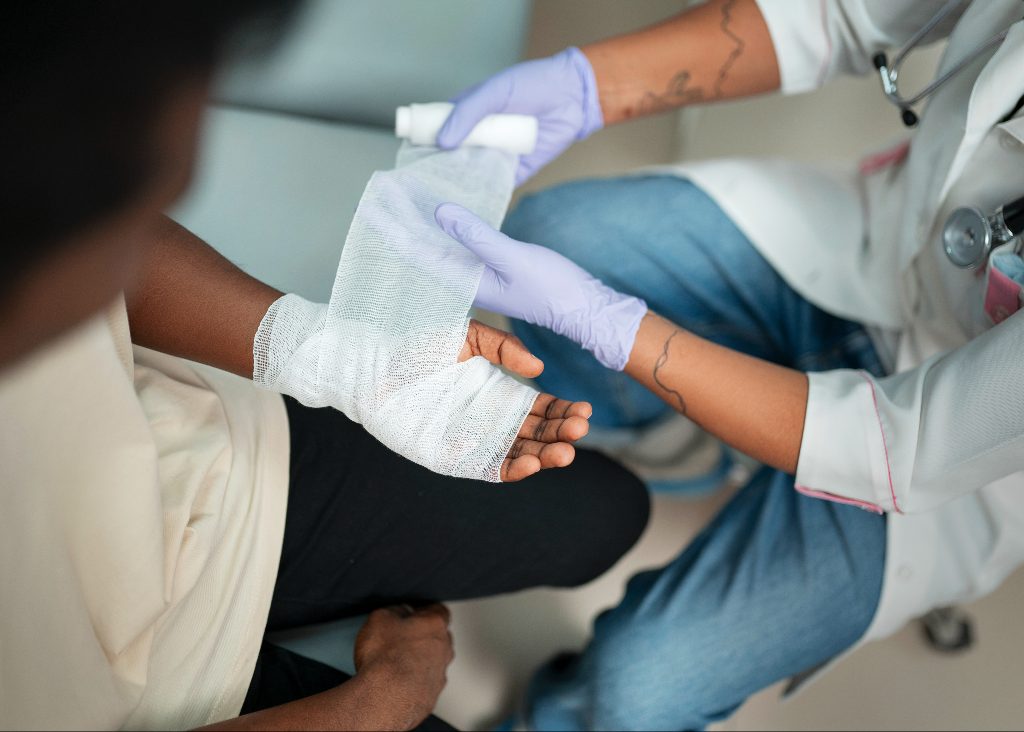Latigazo cervical El latigazo cervical es una lesión frecuente del cuello que se produce cuando la cabeza es sacudida bruscamente hacia delante y hacia atrás, sobre todo en accidentes de automóvil o durante la práctica de deportes de contacto. Aunque los casos leves de latigazo cervical pueden resolverse con reposo y tratamientos sencillos, el latigazo cervical grave requiere cuidados más específicos. Esta lesión puede tener efectos duraderos en el cuello, la columna vertebral y los músculos circundantes si no se trata adecuadamente. El latigazo cervical grave debe ser tratado siempre por un profesional sanitario, pues una atención rápida y adecuada puede producir mejores resultados y prevenir el dolor crónico.
Comprender el latigazo cervical grave: síntomas e impacto en tu cuerpo
El latigazo cervical grave se produce cuando el cuello y la parte superior de la columna soportan una tensión importante, lo que provoca no sólo daños musculares y ligamentosos, sino también posibles lesiones en los discos y nervios del cuello. El violento movimiento de vaivén puede provocar desalineación de las vértebras, distensión muscular y compresión nerviosa.
Los síntomas habituales de un latigazo cervical grave son:
- Dolor intenso en el cuello que se irradia a los hombros o brazos
- Dolores de cabeza persistentes, que suelen comenzar en la base del cráneo
- Rigidez y disminución de la amplitud de movimiento del cuello
- Mareos o visión borrosa
- Hormigueo o entumecimiento en brazos o manos
Si no se trata, un latigazo cervical grave puede provocar dolor crónico, debilidad e incluso dificultades cognitivas debido a lesiones nerviosas o a un flujo sanguíneo deficiente al cerebro. Por eso es esencial un tratamiento rápido para restablecer la función y aliviar el dolor.
Leer más: ¿Cuánto tiempo se tarda en recuperarse de un latigazo cervical?
Los 5 mejores tratamientos para el latigazo cervical grave
El tratamiento del latigazo cervical grave suele requerir una combinación de terapias diseñadas para tratar distintos aspectos de la lesión. Un plan de tratamiento completo aborda el alivio del dolor, el restablecimiento de la movilidad y el fortalecimiento muscular. El objetivo no es sólo tratar los síntomas, sino también asegurar la recuperación a largo plazo y prevenir futuras complicaciones.
1. Fisioterapia: Restablecer la movilidad y la fuerza
La fisioterapia desempeña un papel fundamental en el proceso de recuperación del latigazo cervical grave. Un fisioterapeuta adaptará un programa específico de ejercicios para estirar y fortalecer los músculos que rodean el cuello, reduciendo la rigidez y evitando la atrofia muscular. Los ejercicios específicos, como las inclinaciones del cuello, los giros de hombros y los estiramientos suaves, pueden aumentar la flexibilidad y favorecer la curación.
Además de los ejercicios, los fisioterapeutas pueden utilizar técnicas como la termoterapia, los ultrasonidos o la estimulación eléctrica para reducir la inflamación y estimular el flujo sanguíneo a la zona lesionada. La naturaleza personalizada de la fisioterapia garantiza que el tratamiento se ajuste a la gravedad de la lesión, lo que acelera la recuperación al tiempo que reduce el riesgo de nuevas lesiones.
2. Cuidados Quiroprácticos: Realinear la columna vertebral para aliviar el dolor
La atención quiropráctica es otro enfoque no invasivo que puede ofrecer un alivio significativo a los que sufren un latigazo cervical grave. La desalineación de la columna vertebral es frecuente tras una lesión de este tipo, lo que puede provocar compresión nerviosa, tensión muscular y movilidad reducida. Los quiroprácticos utilizan ajustes de la columna para restablecer la alineación adecuada, lo que puede aliviar la presión sobre los nervios, disminuir la inflamación y mejorar la función general.
Al centrarse en la relación entre la columna vertebral y el sistema nervioso, los ajustes quiroprácticos pueden mejorar la capacidad del cuerpo para curarse a sí mismo. Muchos pacientes descubren que este enfoque no sólo reduce el dolor, sino que también ayuda a restablecer una mayor amplitud de movimiento en el cuello. La atención quiropráctica suele utilizarse junto con otros tratamientos, como la fisioterapia, para una recuperación completa.
3. Tratamiento del dolor: Medicación e inyecciones
Para quienes padecen dolor intenso, la medicación suele ser una parte necesaria del plan de tratamiento. Los analgésicos de venta libre, como el ibuprofeno o el paracetamol, pueden ayudar a controlar los síntomas más leves, pero los casos más graves pueden requerir analgésicos o relajantes musculares con receta para aliviar las molestias.
En algunos casos, pueden recomendarse inyecciones de corticoesteroides para reducir la inflamación de la zona afectada, proporcionando un alivio del dolor más duradero. Sin embargo, el uso prolongado de analgésicos puede provocar dependencia o efectos secundarios como irritación estomacal, daños hepáticos o mareos. Del mismo modo, las inyecciones de corticoesteroides conllevan riesgos como el debilitamiento de los huesos y tendones cercanos o la infección en el lugar de la inyección. Estos tratamientos suelen utilizarse junto con otras terapias para ayudar a los pacientes a recuperar la movilidad y la función, pero deben ser supervisados cuidadosamente por un profesional sanitario.
4. Terapia de Masaje: Reducir la tensión y promover la curación
La terapia de masajes puede ser un modo eficaz de reducir la tensión muscular y mejorar la circulación en pacientes con latigazo cervical grave. Los masajistas cualificados utilizan técnicas como el masaje de tejidos profundos para tratar los músculos tensos, romper el tejido cicatricial y favorecer la curación natural de los tejidos blandos. El masaje también puede aumentar el flujo sanguíneo a la zona lesionada, acelerando la recuperación y reduciendo el riesgo de dolor crónico.
Además de los beneficios físicos, la masoterapia puede proporcionar alivio psicológico, ayudando a los pacientes a relajarse y a controlar el estrés que suele acompañar a las lesiones físicas. Combinada con tratamientos como la quiropráctica y la fisioterapia, la masoterapia ofrece un enfoque completo para tratar los síntomas del latigazo cervical.
5. Cuidados ortopédicos y cirugía para casos graves
En casos raros y graves, como los que implican hernias discales o daños importantes en la columna vertebral, puede ser necesaria la cirugía. Los cirujanos ortopédicos pueden corregir el daño estructural causado por el latigazo cervical, a menudo mediante procedimientos como la discectomía (extirpación de los discos dañados) o la fusión vertebral. Aunque la cirugía suele ser el último recurso, puede cambiar la vida de los pacientes que no han respondido a otros tratamientos.
La idea de la cirugía puede intimidar, pero es importante recordar que la mayoría de los casos de latigazo cervical grave no requieren intervención quirúrgica. Los avances en las técnicas mínimamente invasivas han hecho que la cirugía de columna sea más segura y eficaz que nunca, y tu equipo médico se asegurará de que la cirugía sólo se considere si es absolutamente necesaria.
Por qué el tratamiento precoz es fundamental para la recuperación de un latigazo cervical grave
Tratar precozmente el latigazo cervical puede marcar una diferencia significativa en la rapidez y totalidad de tu recuperación. Si no se trata, lo que empieza como un dolor manejable puede convertirse en molestias crónicas, debilidad muscular e incluso problemas de movilidad a largo plazo. La atención médica inmediata ayuda a atajar las causas profundas -como la inflamación, el daño muscular y la compresión nerviosa- antes de que puedan empeorar.
Retrasar el tratamiento o intentar manejar un caso grave de latigazo cervical por tu cuenta puede llevar a una recuperación prolongada y a una curación incompleta. Una intervención precoz no sólo puede aliviar el dolor, sino también ayudar a recuperar la movilidad, facilitándote la reincorporación a las actividades que te gustan de la forma más rápida y segura posible.
Recibir tratamiento para el latigazo cervical en Ortopedia AICA
En Ortopedia AICA, comprendemos lo abrumador que puede ser un latigazo cervical grave, y estamos aquí para ayudarte a recuperarte con un enfoque integral centrado en el paciente. Nuestro experimentado equipo incluye quiroprácticos, fisioterapeutas, especialistas en el tratamiento del dolor y cirujanos ortopédicos que colaboran para crear un plan de tratamiento personalizado adaptado a tus necesidades.
Tanto si te enfrentas a un dolor agudo como si tienes molestias continuas, estamos aquí para ayudarte. Desde terapias no invasivas, como fisioterapia y quiropráctica, hasta tratamientos más avanzados, como inyecciones o cirugía, Ortopedia AICA proporciona atención experta en cada paso de tu recuperación.
Encuentra el centro de Ortopedia AICA más cercano hoy mismo para una evaluación y un plan personalizado que te ayude a avanzar, sin dolor.





